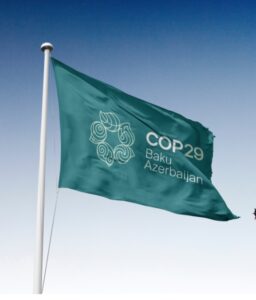What is COP?
The Conference of the Parties (COP) is the central decision-making body under the United Nations Framework Convention on Climate Change (UNFCCC). It gathers 198 parties annually to negotiate and implement global climate policies. Key achievements include the Kyoto Protocol, which established binding emission reduction commitments, and the Paris Agreement (COP21), which united countries in limiting global warming to below 2°C, aiming for 1.5°C. Subsequent conferences, like COP26 in Glasgow, reinforced transparency and financial support for developing nations.
COP29 Overview
When and Where: November 11–22, 2024, in Baku, Azerbaijan, led by COP29 President-Designate H.E. Mukhtar Babayev.
Theme: Known as the “Finance COP,” COP29 focuses on addressing financial, policy, and implementation gaps identified in the first Global Stocktake (GST).
Key Objectives
Climate Finance:
– Establish a New Collective Quantified Goal (NCQG) to mobilize adequate financial resources for developing countries.
– Operationalize the Loss and Damage Fund to help nations facing climate-induced disasters.
Transparency and Reporting:
– Launch the Baku Global Climate Transparency Platform (BTP) to aid countries in preparing Biennial Transparency Reports (BTRs).
– Strengthen the Enhanced Transparency Framework (ETF) to track progress and ensure accountability.
Ambition and Adaptation:
– Encourage enhanced Nationally Determined Contributions (NDCs) and submission of National Adaptation Plans (NAPs) by 2025.
– Accelerate renewable energy capacity (tripling by 2030) and double energy efficiency improvements while phasing out unabated coal power.
 Pillars of COP29
Pillars of COP29
Enhancing Ambition:
The COP29 Presidency encourages all Parties to present 1.50C -aligned Nationally Determined Contributions (NDC) with notable GHG reductions critical for achieving a climate-resilient future as emphasized in the Global stocktake. Responding to developing countries’ challenges in climate adaptation, the COP29 Presidency has urged Parties to submit their National Adaptation Plans (NAPs) by 2025 and to enhance contributions to adaptation funds such as the Green Climate Fund and the Adaptation Fund. Additionally, the COP29 Presidency has prioritized the timely submission of Biennial Transparency Reports (BTRs) to track progress and assess gaps. Over 70 countries will submit their first BTRs by no later than 31 December 2024.
Enabling Action:
COP29 prioritizes the establishment of a fair and ambitious New Collective Quantified Goal on Climate Finance (NCQG) that addresses the needs of developing countries. This goal is essential for bridging the climate finance gap highlighted in the outcomes of the Global Stocktake. Another critical action for COP29 is establishing Article 6 of the Paris Agreement, which will facilitate capital markets and effectively channel financial resources, particularly to developing nations. Building on the progress made at COP27 and COP28, the COP29 Presidency emphasizes the pressing need to operationalize the Loss and Damage Fund fully.
Achievements of COP28
Held in Dubai, UAE, COP28 laid the groundwork for COP29.
Conclusion of the first global stocktake
The COP28 Global Stocktake revealed the need for a 43% reduction in greenhouse gas emissions by 2030 to maintain the 1.5°C threshold, highlighting that current efforts are insufficient. A landmark achievement was the acknowledgment of fossil fuels as the primary drivers of climate change, urging nations to adopt broader emission reduction targets. Key goals include tripling renewable energy capacity, doubling energy efficiency by 2030, phasing down coal, and removing fossil fuel subsidies. The Global Decarbonization Accelerator (GDA) and pledges by 132 countries aim to achieve 11,000 gigawatts of renewable energy and 4% annual efficiency gains. Additionally, the Oil and Gas Decarbonization Charter commits major producers to zero methane emissions and net-zero operations by 2050.
Loss and Damage Fund:
At COP28, a historic agreement operationalized the Loss and Damage Fund, with USD 702 million pledged to help developing nations manage climate disasters beyond their adaptive capacities, advancing climate justice. Additionally, the UN Offices for Disaster Risk Reduction and Project Services were designated to host the Santiago Network Secretariat, providing technical support to at-risk countries.
Global Goal on Adaptation:
At COP28, the Global Goal on Adaptation (GGA) was established with targets to strengthen resilience in key areas like water, food, health, ecosystems, and infrastructure. The framework adopts a forward-looking approach, emphasizing ambition and future progress over past efforts. It aims to guide adaptation planning at all levels while aligning finance, technology, and capacity-building support.
Climate Finance:
At COP28, climate financing took center stage with the launch of ALTÉRRA, a USD 30 billion private finance initiative aimed at mobilizing USD 250 billion for global climate action. Key pledges included USD 12.8 billion for the Green Climate Fund, USD 174 million for the Least Developed Countries Fund, and USD 188 million for the Adaptation Fund.
Major announcements included the UAE Climate and Health Declaration, signed by 151 parties, committing USD 1 billion to protect communities and health systems from climate impacts like extreme heat and disease. Additionally, 160 Heads of State supported food system transformations, with USD 2.6 billion pledged for regenerative agriculture and climate-food innovations.
Challenges and Shortfalls
While COP28 achieved progress, unresolved issues remain:
Fossil Fuel Phase-Out
Ambiguity in commitments to phase out fossil fuels, with loopholes for “transitional fuels” like natural gas.
Insufficient Finance
Financial pledges for the Loss and Damage Fund fall short of the estimated $580 billion required annually by 2030.
Carbon Market Uncertainty
Critical decisions under Article 6 of the Paris Agreement, such as emissions reduction authorizations, were deferred to COP29.
Expectations from COP29
As COP29 approaches, expectations are high for enhanced global cooperation among nations, businesses, and communities. The conference will be a crucial platform for countries to commit to stronger emissions reduction targets, advance adaptation efforts, showcase progress on past pledges, and increase financial support for nations affected by climate-related loss and damage. Key priorities include scaling up climate finance, strengthening adaptation strategies, and accelerating emission reductions.
Strengthening Global Climate Finance
COP29 will aim to set a new climate finance target post-2025, building on the current USD 100 billion commitment. This target will focus on both the quantity and quality of climate finance, ensuring fair contributions and encouraging private sector participation to bridge the finance gap.
Elevating National Climate Ambitions
With the 2025 deadline for Nationally Determined Contributions (NDCs) approaching, countries must set ambitious climate targets under the Paris Agreement. COP29 leaders are expected to commit to phasing out fossil fuels and tripling renewable energy capacity by 2030, raising the bar for future climate action.
Enhancing the Loss and Damage Fund
This year, progress was made on the Loss and Damage Fund, with the Philippines appointed as the board host and new partnerships formed with the World Bank. At COP29, negotiators aim to strengthen the Warsaw International Mechanism (WIM), align it with the Loss and Damage Fund, and enhance support for vulnerable nations through the Santiago Network.
Driving Action on Adaptation
COP29 will help countries move from National Adaptation Plans (NAPs) to tangible implementation. Increased funding pledges, particularly for adaptation and loss and damage initiatives, are expected to further support vulnerable countries in tackling climate impacts.
Integrating Climate, Nature, and Land Goals
As part of the “triple COP” year, COP29 coincides with major conferences on biodiversity and desertification, underscoring the need for integrated solutions to climate change, biodiversity loss, and land degradation. Additionally, the outcomes of the World Urban Forum (WUF), held before COP29, will shape discussions, emphasizing urban resilience in climate action.
Establishing a Unified Climate Finance Taxonomy
As COP29 host, Azerbaijan will introduce unified standards for sustainable investments developed with over 100 countries. This new taxonomy aims to simplify green finance, promote emissions reductions, and streamline green loan issuance. Azerbaijan is also committed to investing heavily in green projects until 2030, aligning its financial systems with sustainable goals.
Conclusion
COP29 in Baku represents a pivotal opportunity to address urgent climate challenges. By focusing on finance, ambition, and transparency, it aims to ensure that commitments translate into actionable solutions. As we look forward to COP30, the collective efforts initiated at COP29 will be critical in shaping a sustainable, equitable, and climate-resilient future.




